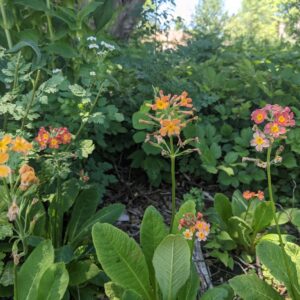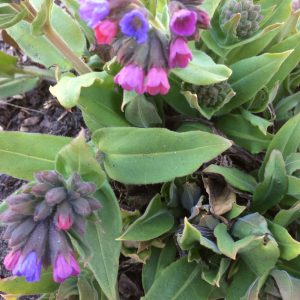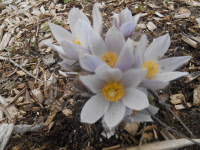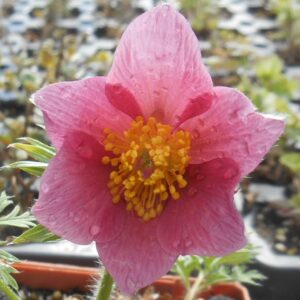Shop
- Sorry, this product cannot be purchased.
Showing 601–608 of 788 results
-
Primula vulgaris syn. Primula acaulis English primrose Z 4-8
Primrose yellow blossoms in earliest of spring.
ARCHIVED
Note: This is a plant not currently for sale. This is an archive page preserved for informational use.
Primrose yellow blossoms cheer on the earliest of spring.
Size: 6" x 6"
Care: shade in moist to moist well-drained soil. Immune to Walnut toxicity
Native: Europe
Awards: Received England’s Royal Horticultural Society Award of Merit.Primula is from Italian “primavera” meaning first spring. Vulgaris means common. Grown in the Eichstätt Garden, the garden of Johann Konrad von Gemmingen, prince bishop of Eichstätt in Bavaria, c. 1600. Grown by Jefferson. Grown at America’s 1st botanic garden, Elgin Botanic Garden 1811. Old medicinal uses to cure gout and headaches.
-
Primula x bulleesiana Candelabra primrose Z 4-7
From clustered stems, each bearing a whorl of 3-6 flowers encircling each leafless stem alternating with a bare section of leafless stem, then another whorl of flowers, then another section of bare stem, in tiers, like a ballerina’s tutu with bare midriff between. Each whorl blooms in succession from the bottom up. This blooms June – July in a rainbow of colors - red, orange, rose, cream, lavender and purple.
OUT OF STOCK
From clustered stems, each bearing a whorl of 3-6 flowers encircling each leafless stem alternating with a bare section of leafless stem, then another whorl of flowers, then another section of bare stem, in tiers, like a ballerina’s tutu with bare midriff between. Each whorl blooms in succession from the bottom up. This blooms June – July in a rainbow of colors – red, orange, rose, cream, lavender and purple.
Size: 18-24” x 12-18”
Care: Sun to part shade in moist to well-drained soil
Wildlife Value: Attracts butterflies. Deer resistant
Awards: Royal Horticultural Society Award of Garden Merit 1993Hybrid cross between Primula bulleyana and Primula beesiana (both parents are native to the Himalayas and China).
Collected in China, introduced to Britain in 1906 -
Pulmonaria angustifolia Narrow-leaf lungwort, Blue cowslip Z 4-8
One of the earliest to flower - Pink turning azure blue, trumpet-shaped flowers in April- May. Fuzzy foliage.
Welcome spring with this very early flower – Pink trumpet-shaped flowers turn deep blue in early sprng.. Fuzzy foliage.
Size: 12”x 12”
Care: full to part shade in moist to moist well-drained soil.
Native: Austria & Hungary.
Wildlife Value: walnut and deer tolerant. Early source of nectar for bees.
Awards: Royal Horticultural Society Award of Garden MeritAngustifolia means “narrow leaves.” Grown in gardens before 1590’s.
-
Pulmonaria saccharata ‘Mrs. Moon’ Greater lungwort, Bethlehem sage Z 3-8
In early spring funnel form pink flowers turn to blue above bristly, white mottled green foliage. Leaves attractive through fall
OUT OF STOCK
In earliest spring funnel form pink flowers turn to blue above bristly, white mottled green foliage. Leaves attractive through fall
Size: 8-18” x 18-24”
Care: full to part shade in moist well-drained soil
Native: species France & Italy
Wildlife Value: walnut and deer tolerant. Early source of nectar for bees.The species originally described by English botanist and gardener to Queen Mary, Leonard Plukenet (1641-1706) .Described by Philip Miller (1768) as having “spotted leaves as if they were incrusted with sugar.” ‘Mrs. Moon’ cultivar offered for sale in 1938 by Gardenside Nurseries in Shelburne VT. Name Pulmonaria from Latin pulmo or lung (e.g.today’s pulmonary) because the blotched leaves were considered to resemble lung disease. Saccharata comes from Latin word for sugar because the white bristly leaves resembled sugar coating.
-
Pulsatilla patens syn. Anemone patens Eastern pasque flower Z 3-7
Up-facing blue-violet bells in early spring emerge from foliage decorated with silky hairs.
ARCHIVED
Note: This is a plant not currently for sale. This is an archive page preserved for informational use.
Up-facing blue-violet bells in early spring emerge from foliage decorated with silky hairs.
Size: 8-12” x 4-6" slow to grow, so be patient
Care: sun in moist well-drained to well-drained soil
Native: northern Great Plains including WI, Siberia, AlaskaThe name Pasque is Old French for Easter referring to the spring bloom time. Patens means “spreading.” South Dakota honors this as its state flower.
Collected for gardens prior to 1753. The Blackfoot made a decoction of this plant to speed a baby’s delivery and applied crushed leaves to skin to remedy irritation. Omaha applied fresh, crushed leaves as a poltice for rheumatism. -
Pulsatilla vulgaris var. ‘Alba’ Z 4-8
Pure white petals of open bell-shape with yellow centers flowers in early spring. Fun, furry foliage and Medusa-like seed heads.
ARCHIVED
Note: This is a plant not currently for sale. This is an archive page preserved for informational use.
Pure white petals of open bell-shape with yellow centers flowers in early spring. Fun, furry foliage and Medusa-like seed heads.
Size: 8-12” x 8-12”
Care: sun to part shade in well-drained to moist well-drained soil
Native: Europe
Wildlife Value: Deer resistant, early pollen source for bees
Awards: Royal Horticultural Society Award of Garden Merit“There is a variety of (Pulsatilla vulgaris) with white flowers…” Gardeners Dictionary, 1768.
-
Pulsatilla vulgaris var. rubra syn. Anemone pulsatilla var. rubra Pasqueflower
Wine-red petals of bell-shape with yellow centers flowers in early spring. Fun, furry foliage
ARCHIVED
Note: This is a plant not currently for sale. This is an archive page preserved for informational use.
Wine-red petals of bell-shape with yellow centers flowers in early spring. Fun, furry foliage and Medusa-like seed heads.
Size: 12-20” x 4-8”
Care: sun in well-drained to moist well-drained soil
Native: Europe
Wildlife Value: Deer resistant, early pollen source for bees.Called Pasqueflower because it blooms at Easter time. Variety rubra considered a separate species, not a variety, by Caspar Bauhin in Theatri botanici, 1671. Illustrated in Gerard’s Herball, 1636.
-
Punica granatum var. nana Dwarf pomegranate Z 7-11
Adorable dwarf shrub bearing orange-red blooms in July and August then tiny, edible pomegranates. Where not hardy makes good container plant and bonsai.
ARCHIVED
Note: This is a plant not currently for sale. This is an archive page preserved for informational use.
Adorable dwarf shrub bearing orange-red blooms in July and August then tiny, edible pomegranates. Where not hardy makes good container plant and bonsai.
Size: 2-4’ x 2-4’
Care: sun to part shade in moist well-drained to well-drained soil
Native: Europe to Himalayas“The plants will bear miniature fruit if grown in areas with year-round temperatures that rarely fall below 40° F. To grow indoors, moderate night-time temperatures should be given (50° to 60° F). Keep at 40° to 45° F in winter until new growth appears. In the growing period, keep moderately moist. Water sparingly from August on. This plant requires good drainage. Plants will bear fruit indoors if grown in a sunny exposure.” Issour Botanic Garden. It is deciduous and may lose its leaves.
This dwarf described in 1803.





